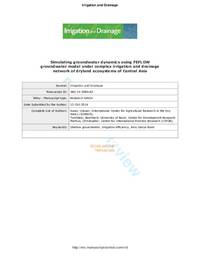Simulating groundwater dynamics using FEFLOW groundwater model under complex irrigation and drainage network of dryland ecosystems of Central Asia

Authors:
Surface and groundwater resources are often conjunctively used to cope with water scarcity in irrigated agriculture. Farmers in the dryland ecosystems of central Asia also utilize shallow groundwater in addition to surface water withdrawn from rivers. This study modelled groundwater dynamics in an irrigation and drainage network in Khorezm region, Uzbekistan. The system, characterized by a vast, unlined channel network used to convey water mainly for flood irrigation and an open drainage system, is typical of Central Asian irrigated areas. Groundwater levels in the region are shallow—this contributes to crop water requirements but threatens crop production through secondary salinization. High losses during irrigation in fields and through the irrigation network are the main causes of these shallow groundwater levels. The main objective of this study was thus to simulate groundwater levels under improved irrigation efficiency scenarios. The FEFLOW-3D model, applied in a case study to the water users’ association (WUA) of Shomakhulum in south-west Khorezm, was used to quantify the impact of improved irrigation efficiency scenarios on groundwater dynamics. The modelled scenarios were: current irrigation efficiency (S-A, our baseline), improved conveyance efficiency (S-B), increased field application efficiency (S-C), and improved conveyance and application efficiency (S-D). Recharge rates were separately determined for six hydrological response units (differing in groundwater level and soil type) and introduced into the FEFLOW-3D model. After successful model calibration (R2 = 0.94) and validation (R2 = 0.93), the simulations showed that improving irrigation efficiency under existing agro-hydroclimatic conditions would lower groundwater levels from the baseline scenario (S-A) in August (the peak irrigation period) on average by 12 cm in S-B, 38 cm in S-C and 44 cm in S-D. Any interventions which would improve irrigation efficiency will lower the groundwater levels and hence policy makers should consider them and formulate the policy accordingly.
